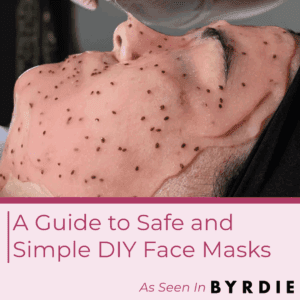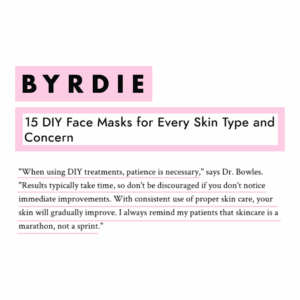A Guide to Safe and Simple DIY Face Masks | As Seen in Byrdie
Homemade treatments can be a fun and affordable way to care for your skin, when done right. From nourishing face masks to natural exfoliants, DIY skincare offers a wide range of benefits using ingredients you may already have at home. Hear Dr. Alexandra Bowles’ thoughts on certain ingredients and methods in Byrdie’s article.

What to Know Before You Try DIY Skincare:
Try a Test Patch
Before applying any DIY treatment, I always recommend starting with a patch test. By applying a small amount of the product to an inconspicuous area (such as your jawline or wrist), you can check for any allergic reactions or irritation before applying it more broadly. This step is crucial to avoid any unexpected issues.
Be Mindful of the Ingredients You’re Using
While natural ingredients are often perceived as safe, they can still be harsh on your skin. Ingredients like lemon juice or baking soda, for example, may sound gentle but can irritate your skin, especially with regular use. From my experience, it’s essential to consider your skin’s needs and sensitivities before using any ingredient to avoid potential harm.
Don’t Overdo It
More isn’t always better when it comes to skincare. Overusing DIY treatments, particularly exfoliants or masks, can damage your skin’s protective barrier, leading to irritation and breakouts. I always suggest limiting their use to once or twice a week, depending on your skin’s condition, to avoid overloading it.
Consider Your Skin Type
Your skin type plays a huge role in determining which DIY treatments will work best. For example, if you have oily skin, clay masks can help absorb excess oil, leaving your skin feeling fresh. For dry or sensitive skin, however, hydrating masks with ingredients like honey or aloe vera are gentler and won’t strip your skin’s moisture, which is essential for maintaining a healthy glow.
Consistency Is Key
When using DIY treatments, patience is necessary. Results typically take time, so don’t be discouraged if you don’t notice immediate improvements. With consistent use of proper skincare, your skin will gradually improve. I always remind my patients that skincare is a marathon, not a sprint.

DIY Doesn’t Replace Professional Care
Although DIY skincare treatments can be beneficial, they shouldn’t replace professional skincare or dermatological advice. For persistent skin issues like acne, eczema, or rosacea, I strongly advise consulting with a dermatologist for a tailored treatment plan that addresses your unique needs.
Don’t Forget Sunscreen
Even if you’re using natural ingredients, don’t forget to protect your skin with sunscreen. Some ingredients, like citrus or honey, can increase your skin’s sensitivity to the sun. For optimal protection, make sure you apply SPF 30 or higher, especially if you’re using DIY treatments regularly.
Explore the science behind common DIY skincare ingredients and methods, and learn how to use them effectively and safely!
Avocado: Avocados are packed with omega-3 fatty acids, vitamin E, and antioxidants, making them a powerhouse for skin hydration and nourishment. These nutrients help to improve skin elasticity, reduce dryness, and give your skin a healthy, plump appearance. I’ve found that avocados are especially beneficial for dry, normal, or mature skin types, providing intense moisture.
Brown Sugar: Brown sugar is a gentle, natural exfoliant that helps remove dead skin cells, revealing smoother and brighter skin. While it can improve skin texture, it may be too abrasive for those with sensitive or dry skin, so I always recommend exfoliating gently and testing first.
Turmeric and Yogurt: Turmeric is known for its anti-inflammatory and antioxidant properties, helping to soothe and calm the skin. When mixed with yogurt, it hydrates and exfoliates gently, making it an ideal choice for dry or aging skin in need of extra brightness and balance.
Milk: Milk contains lactic acid, a mild exfoliant that gently removes dead skin cells while adding moisture to the skin. It’s particularly effective for dry skin, as it helps to refresh and smooth the complexion, leaving skin soft and glowing.
Coconut Oil and Cocoa Butter: Coconut oil is deeply hydrating, while cocoa butter is rich in fatty acids and antioxidants. Together, these ingredients lock in moisture and leave the skin feeling smooth and nourished. However, I advise those with oily or acne-prone skin to be cautious, as coconut oil may clog pores, potentially leading to breakouts.
Dark Chocolate: Dark chocolate is packed with antioxidants that help protect the skin from environmental damage. Additionally, its hydrating properties make it a great option for dry skin that needs some extra nourishment. Its rich texture helps to replenish moisture, leaving the skin looking smooth and radiant.
Strawberry: Strawberries contain salicylic acid, a natural exfoliant that clears pores and smooths skin. They’re beneficial for oily or acne-prone skin, preventing breakouts while brightening the complexion due to their high vitamin C content.
Honey: Honey is a natural humectant, which means it draws moisture into the skin and helps retain hydration. It also has antibacterial properties, making it ideal for acne-prone skin. Honey works to soothe and hydrate the skin, promoting a healthy, soft texture.
Aloe Vera and Cucumber: Aloe vera is well-known for its soothing and hydrating qualities, making it perfect for sensitive or irritated skin. When combined with cucumber, these two calm the skin and reduce puffiness, making it ideal for a refreshing and cooling treatment.
Oatmeal: Oatmeal is a gentle exfoliant that helps absorb excess oil while soothing inflamed or irritated skin. It’s perfect for sensitive or acne-prone skin, as it provides a non-abrasive way to refresh and maintain a healthy complexion without irritation.
Sugar or Salt Scrubs: Salt and sugar scrubs are effective exfoliants that remove dead skin cells and enhance skin texture. Sugar is generally gentler than salt, making it a better choice for the face. However, both can be too harsh for sensitive skin, so patch testing is crucial before use.
Paraffin Wax Treatment for Hands: Paraffin wax is an excellent treatment for dry, cracked hands, providing intense moisture and leaving the skin feeling soft and supple. I recommend patients with cracked and dry skin do this three times weekly when they are flared or during winter months to create a form of seal on their hands and lock in moisture. You can do this on heels as well!
Foot Scrub for Dry, Cracked Heels: A foot scrub is a great way to tackle dry, cracked heels. It exfoliates and softens tough skin, helping to maintain smooth, healthy-looking feet, particularly during the warmer months when feet are more exposed.
